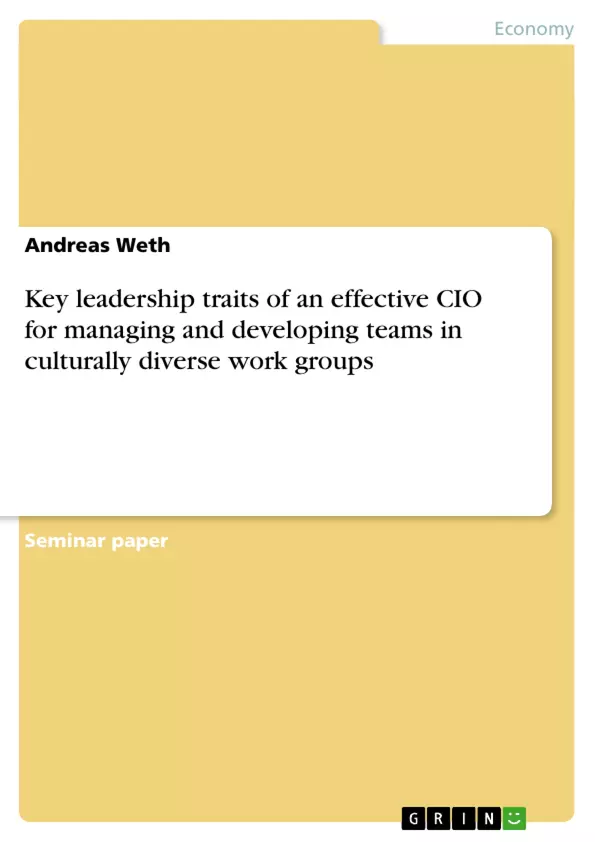In these days, leadership seems to be a critically researched topic. Morse (2004) discusses executive psychopaths and Maccoby (2004) analyses problems with narcissistic leaders. According to them, there is a high quota of unsuccessful leaders (Morse, 2004 & Maccoby, 2004) and therefore it is getting more and more important to identify and validate key leadership traits before employing leaders to avoid costly top level management debacles. Especially an unsuccessful CIO can be very expensive for a company due to high business risks which result from the use of information technology (think about the huge risks companies are facing when they are implementing an ERP solution in a multimillion dollar project). With increasing pressure, the CIO (who is in my interpretation in the graphic on page two the tiny manager in front of the desk who is trying to look up to the CEO) is in a difficult position. Being supervised by the CEO (displayed in the picture on page too as the manager behind the desk whose view seems to be clouded), he has to manage culturally diverse teams in the complex and changing business and IT environment. His function is to coordinate IT as a tool to support business functions and value adding processes, in the context of Porter’s value chain. (Porter, 1998) This leads to the need for the CIO to understand and integrate two aspects: the business side and the IT related aspects. The problem is that in most cases, even the CIO is not able to understand every detailed aspect of information technology and of the conducted business. Therefore he has to manage with a lack of information and lead a team consisting of different and often culturally diverse specialists.
This essay analyses and describes traits of an effective CIO with the use of current leadership literature, in particular with references to the work from Warren Bennis, Abraham Zaleznik and Daniel Goleman. Identified traits and significant findings are highlighted (bold) to give to focus the reader on the most important aspects.
Inhaltsverzeichnis (Table of Contents)
- Introduction
- Definition of leadership
- Analysis of CIO leadership traits
- General leadership traits
- Traits for leaders in the position of a CIO
- Leadership traits for a CIO to manage culturally diverse groups
- Leadership traits for a CIO to develop effective teams
- Conclusion
Zielsetzung und Themenschwerpunkte (Objectives and Key Themes)
This essay aims to analyze and describe the traits of an effective CIO, drawing upon current leadership literature and focusing on the work of prominent figures like Warren Bennis, Abraham Zaleznik, and Daniel Goleman. The objective is to identify key leadership traits that contribute to successful CIO leadership in the context of managing culturally diverse teams and developing effective teams.
- The importance of identifying key leadership traits to avoid costly management debacles
- The challenges faced by CIOs in managing culturally diverse teams and navigating complex business and IT environments
- The critical role of CIOs in coordinating IT to support business functions and value-adding processes
- The need for CIOs to understand both business and IT aspects while working with diverse teams
- The significance of creativity, vision, and the ability to analyze and assess potential technical ideas for CIO leadership
Zusammenfassung der Kapitel (Chapter Summaries)
- Introduction: This chapter highlights the significance of effective CIO leadership in the context of modern business challenges and the growing importance of information technology. It introduces the complexities of the CIO's role, particularly in managing diverse teams and navigating the intersection of business and IT.
- Definition of Leadership: This chapter explores various definitions of leadership, differentiating between management and leadership. It emphasizes the importance of inspiration, human passion, and a tolerance for chaos in effective leadership.
- Analysis of CIO Leadership Traits: This chapter delves into the analysis of leadership traits, both general and specific to the CIO role. It introduces the idea that effective leaders share common traits across industries and explores the specific qualities necessary for CIOs to succeed in managing diverse teams and developing effective teams.
Schlüsselwörter (Keywords)
Key terms and concepts explored in this work include: CIO leadership, leadership traits, culturally diverse teams, effective teams, information technology management, business strategy, value chain, inspiration, human passion, chaos, management versus leadership, vision, creativity, and the work of prominent leadership theorists like Warren Bennis, Abraham Zaleznik, and Daniel Goleman.
- Citation du texte
- Andreas Weth (Auteur), 2005, Key leadership traits of an effective CIO for managing and developing teams in culturally diverse work groups, Munich, GRIN Verlag, https://www.grin.com/document/41862



